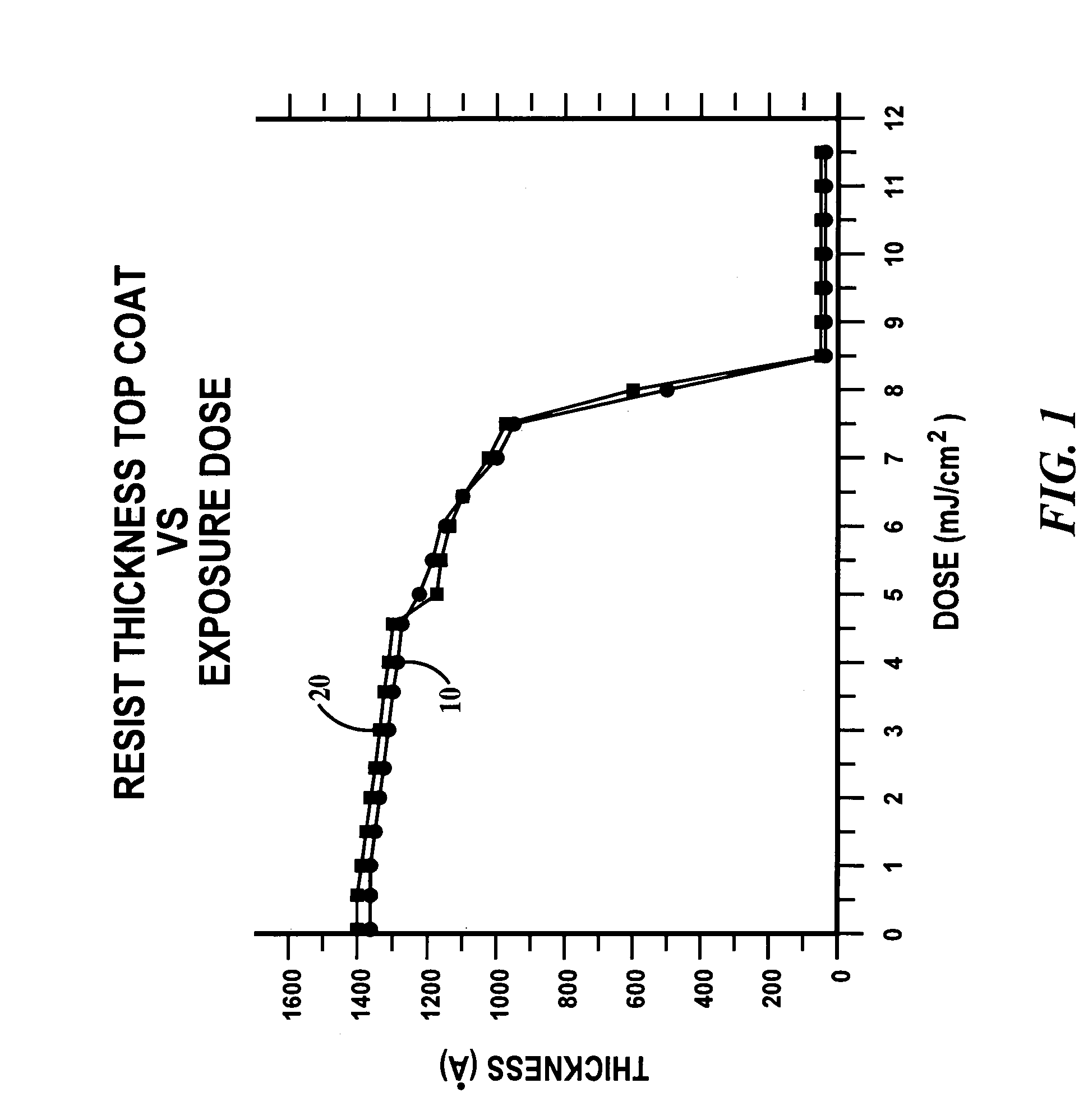Photoresist topcoat for a photolithographic process
a photolithographic process and resist topcoat technology, applied in the field of nonpolymer chemistry, photolithography and semiconductor fabrication, can solve problems such as performance degradation, and achieve the effect of low absorption
- Summary
- Abstract
- Description
- Claims
- Application Information
AI Technical Summary
Benefits of technology
Problems solved by technology
Method used
Image
Examples
synthesis examples
[0041]The silesesquioxane starting materials were purchased from TAL Materials Inc., and Hybrid Plastics. Tetracyclo[4.4.0.12,5.17,12]dodec-3-ene starting materials were obtained from JSR corporation. All the other reagents were purchased from Aldrich Chemical Company. The products were characterized by NMR, IR, DSC, TGA, and GPC. The GPC traces of all the products showed a small shoulder on the high molecular weight side of the main peak. These are thought to be dimers formed during the reaction (J. V. Crivello, and R. Malik, “Synthesis and Photoinitiated Polymerization of Monomers with the Silsesquioxane Core”, J. Polym. Sci., Part A: Polymer Chemistry, Vol. 35, 407-425, (1997)). In some cases, the base soluble derivatives were synthesized in the casting solvent and used as is.
[0042]Characterization of POSS resin performance was performed using a Quartz Crystal Microbalance (QCM) for dissolution properties, water uptake and film interaction studies. Lithographic behavior was evalu...
example 1
Synthesis of a Carboxylic Acid / Ester POSS Derivative
[0043]
[0044]Octakis(dimethylsilyloxy)silsesquioxane (Q8M8H) (2.54 grams, 0.0025 mole), cis-5-norbornene-endo-2,3-dicarboxylic anhydride (3.28 grams, 0.020 mole), and tetrahydrofuran (THF) (20 ml) were placed in a round bottom flask equipped with a magnetic stirrer, nitrogen inlet, and a water condensor. Platinum(0)-1,3-divinyl-1,1,3,3-tetramethyldisiloxane complex in xylene (1 ml) was added to this mixture and stirred at room temperature for 1 hour and heated to reflux for 1 more hour. According to the IR spectrum of the reaction product, the reaction was complete. The solvent was removed in a rotary evaporator and the residue was dried under vacuum at room temperature. To the above solid, n-butanol (50 grams), dimethylamino pyridine (DMAP) (50 milligrams) were added and heated to reflux for 1 hour. According to the IR spectrum of the reaction product, the reaction was complete. This solution was stirred with amberlist 15 (washed, ...
example 2
Synthesis of N-Hydoxyimide POSS Derivative
[0045]
[0046]Octakis(dimethylsilyloxy)silsesquioxane (Q8M8H) (2.0 grams, 0.002 mole), endo-N-hydroxy-5-norbornene-2,3-dicarboximide (2.96 grams, 0.016 mole)), and tetrahydrofuran (THF) (20 milliliters) were placed in a round bottom flask equipped with a magnetic stirrer, nitrogen inlet, and a water condenser. Platinum(0)-1,3-divinyl-1,1,3,3-tetramethyldisiloxane complex in xylene (1 ml) was added to this mixture and stirred at room temperature for 1 hour and heated to reflux for 1 more hour. According to the IR spectrum of the reaction product, the reaction was complete. The reaction mixture was cooled to room temperature and added dropwise into hexane (400 milliliters). The solid was filtered through a frit funnel, air dried for a 4 hours and then dried under vacuum at 55° C., overnight (yield, 73%).
PUM
| Property | Measurement | Unit |
|---|---|---|
| temperature | aaaaa | aaaaa |
| wavelength | aaaaa | aaaaa |
| transparent | aaaaa | aaaaa |
Abstract
Description
Claims
Application Information
 Login to View More
Login to View More - R&D
- Intellectual Property
- Life Sciences
- Materials
- Tech Scout
- Unparalleled Data Quality
- Higher Quality Content
- 60% Fewer Hallucinations
Browse by: Latest US Patents, China's latest patents, Technical Efficacy Thesaurus, Application Domain, Technology Topic, Popular Technical Reports.
© 2025 PatSnap. All rights reserved.Legal|Privacy policy|Modern Slavery Act Transparency Statement|Sitemap|About US| Contact US: help@patsnap.com



